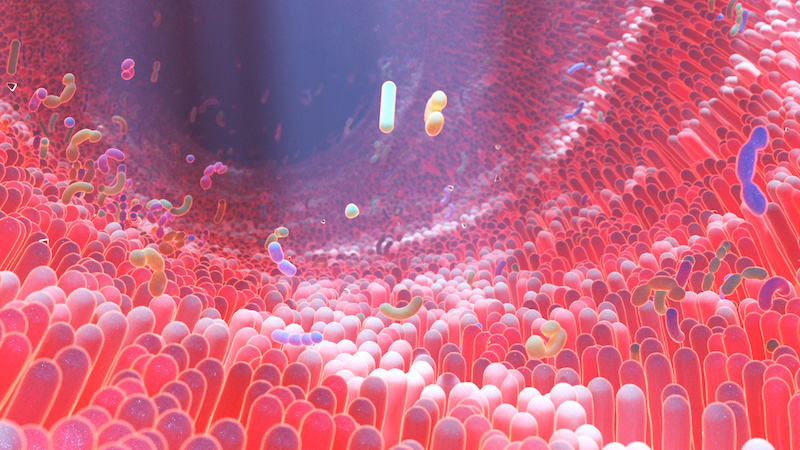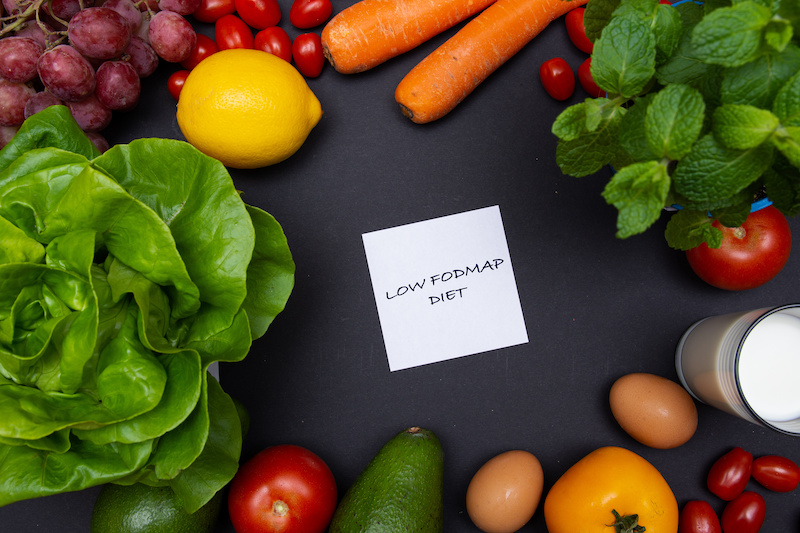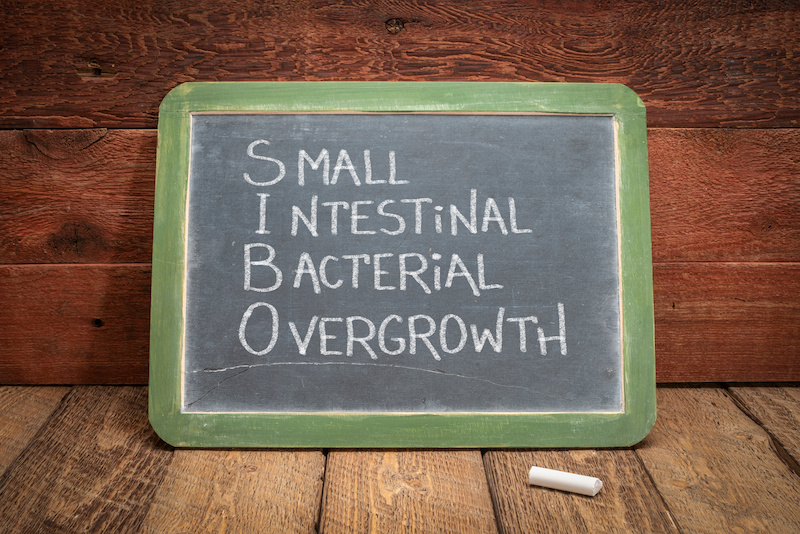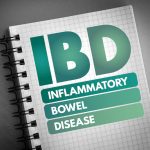One of the reasons I became a naturopath is because I was plagued with gut issues for many, many years. For this reason, in addition to my university degree, I have invested heavily in mentoring by digestive experts and consistently spend time undergoing further studies on gut microbiome and digestive conditions. For this reason, I have a regular flow of individuals in my award winning naturopath clinic in Sydney seeking support for their chronic or recent gut issues. Bloating, pain, reflux, constipation, loose stools, reactions to foods and more are common complaints.
These days it’s common knowledge that the microbiome – the colonies of bacteria, viruses and fungi that live in our large intestine – are integral to our health and wellbeing and can affect not only our physical but even our mental health. Many people have heard the term “dysbiosis” and understand that an imbalance of microbes in the large intestine can have negative health consequences. However, Small Intestinal Bacterial Overgrowth (SIBO) and also colonic overgrowth remains relatively unheard of by the general population, even as research catches up to the naturopathic knowledge that it is a common issue affecting many of us. So, what is SIBO and how does it occur? In this blog post we take a look into the microbiome, how SIBO develops, and how we can combat this condition using diet, lifestyle, and natural therapeutics.
The Microbiome
The gastrointestinal microbiome is the largest population of microbes in the human body. Approximately 3.8 trillion bacteria reside in our large intestine alone. In fact, the microbiome is made up of roughly ten times as many microbes as there are cells in our entire body. It is primarily composed of different types of bacteria, but also includes some species of fungi and viruses, too. Up to 1,000 different species of bacteria may reside in your large intestine. The microbiome is involved in so many aspects of our health – immune system function, hormonal balance, neurotransmitter function (90% of the body’s serotonin is actually produced by our gut microbiome!) and more. A healthy microbiome relies on overall gastrointestinal health and a good quality diet rich in fibre and fermented foods, which provide both pre- and probiotics to maintain healthy microbial populations. This community of live species also require a healthy gut, pH and lack of inflammation to thrive and in doing so, benefits the health of your whole body.
What is SIBO?
Small intestinal bacterial overgrowth (SIBO) (which also occurs in the colon (large intestine)in some people), is an excessive and/or abnormal bacterial growth in the small intestine. The small intestine is normally only sparsely populated by bacteria, with small numbers of species such as lactobacilli and enterococci. In some people, there won’t be any bacteria at all in the upper part of the small intestine. SIBO occurs when bacterial populations from lower down the gastrointestinal tract migrate up the gut and colonise the small intestine. These microbes feed on carbohydrates in foods and drinks, producing gases including hydrogen, methane and hydrogen sulphide as a consequence of this feeding process. The bacteria also produce endotoxins as metabolic waste products, which cause inflammation and damage to the intestinal wall, impairing nutrient absorption. Important enzymes and the small, finger-like protrusions (known as microvilli) normally found in the small intestine are lost. Damage to the intestinal lining makes the gut wall more permeable, allowing potentially harmful substances to be absorbed into the blood stream. It also means that many people will have secondary food intolerances because ethe villi are damaged and the enzymes that live in these villi, literally have no home. I call them secondary food intolerances, because when the gases are gone, the villi recover, the enzymes have a place to live, and food can now be breakdown down and absorbed properly. It also means that many people can return to eating these foods again once the overgrowth is cleared.

Causes of SIBO
The body has several defence mechanisms that help to prevent the development of SIBO by creating an intestinal environment that suits beneficial bacteria, while preventing the growth of pathogenic bacteria. Gastric acid in the stomach provides a highly acidic pH, which prevents the growth of certain strains of bacteria, while promoting the growth of others. Likewise, secretions from the pancreas and gall bladder also help to control microbial populations in the small intestine and play an important role in keeping the microbiome populations healthy. The motility of the intestinal tracts also helps to keep food and fluids moving regularly through the gut, preventing stasis. This helps to prevent food sources for pathogenic bacteria being available in the gut long enough for harmful populations to grow. SIBO typically develops because the environment in the small intestine has changed and is no longer able to protect against bacterial colonisation. There are a huge range of potential causes and often there are multiple different factors at play when SIBO develops. Potential risk factors and causes of SIBO include:
Post infectious IBS
- Food poisoning or infections for drinking water or more can damage the nerves in your gut responsible for proper motility. Many people who have had Bali belly, food poisoning overseas/in Australia or a terrible gut infection episode often find that their gut has never been the same since.
Medication use
- Proton pump inhibitors (PPIs) are common medications prescribed for reflux, heartburn and managing gastric ulcers, which reduce the acidity in the stomach. Reducing the stomach’s acidity affects the pH in the small intestine too, lowering defences for colonisation from bacteria that thrive in a less acidic environment. Studies show up 50% of long-term PPI users may have SIBO.
- Opioid medications – these drugs delay transit time in the gut, making it easier for bacterial populations to move into the small intestine.
Chronic pancreatitis, poor liver function, non-alcoholic fatty liver disease, gall bladder removal
- Pancreatic enzymes and bile are both important for maintaining gut health. Insufficient levels of either of these secretions can lead to SIBO.
Poor gut motility
- Poor gut motility, such as with chronic constipation or hypothyroidism, means foods that can feed harmful bacteria remain available in the gut for too long. It also means harmful substances meant for excretion can sit in the gut and cause inflammation, worsening symptoms related to SIBO. Other causes of slow motility can include endometriosis on the bowel, scarring, Inflammatory Bowel Disease and more.
Age (over 75 years)
- With increasing age, motility slows down and the body produces fewer gastric secretions, meaning reduced protection against SIBO.
Stress
- Stress causes huge problems for health and is associated with myriad other health conditions. Anxiety driven IBS can be powerful. In SIBO, it can trigger symptoms by suppressing the normal production of important secretions such as gastric acid. It also slows down motility in the gut, reduces blood flow to the gut and impairs immune function, leaving us without many of the defences that normally protect us against SIBO.
Immune dysfunction
- Conditions that affect the immune system, such as autoimmune conditions, AIDS, and even coeliac disease, can lead to a greater risk of SIBO.
Signs and Symptoms of SIBO
The symptoms of SIBO are variable and often non-specific, which can make diagnosis difficult. There are many other gastrointestinal conditions that can also present in the same way as SIBO. Signs and symptoms of SIBO may include some or all of these:
- Bloating which often gets worse throughout the day
- Reactions to certain foods
- Pain
- Flatulence
- Frequent belching
- Reflux and heartburn
- Diarrhoea
- Constipation
- Nausea
- Fatigue
- Brain fog
- Joint pain
- Signs of malabsorption and nutrient deficiencies, such as iron or vitamin B12 deficiency
Associated Health Conditions
SIBO is a condition that naturopaths have long understood to be a significant contributor to health problems such as IBS. However, it’s only been relatively recently that SIBO has become better recognised by the wider medical community and is becoming more commonly diagnosed. In the past, naturopathic understandings of SIBO as contributing to other health conditions were often dismissed, although advances in knowledge of SIBO have demonstrated that it is, in fact, much more common than previously thought, and is associated with many other health conditions, too. Other conditions that can be associated with SIBO include:
- IBS
- Rosacea
- Dyspepsia
- Coeliac disease
- Inflammatory bowel disease (Crohn’s disease and ulcerative colitis)
- Restless legs syndrome
- Small bowel diverticula
- Pancreatitis
- Hypothyroidism
- Parkinson’s disease, rheumatoid arthritis
- Type 2 Diabetes
- Coronary artery disease
- Past history of abdominal surgery, such as gastric bypass, hysterectomy, or gall bladder removal
- Fibromyalgia
- Non-alcoholic fatty liver disease, cirrhosis
SIBO and IBS
Studies show a correlation between IBS and SIBO. One of the common ways by which IBS and SIBO can be interrelated is through post-infective IBS as mentioned above – that is, IBS that is caused by a gastric illness such as food poisoning. Infection with a gastric pathogen (such as Salmonella or E. Coli) causes an immune response by the body, including the production of antibodies. This ends up causing damage to the nerves that are responsible for gut motility but also to the body’s own intestinal wall, leading to symptoms of constipation or diarrhoea and creating the ideal environment for SIBO.
Nutritional Consequences of SIBO
SIBO can have a number of detrimental effects on nutritional status. As mentioned above when the excess hydrogen and methane gases produce by bacteria destroy villi, absorption and breakdown of foods is impacted, causing digestive symptoms.
Microbes also compete for absorption of important nutrients such as protein, B12, B1 and B3, which can lead to nutrient deficiencies and symptoms of fatigue. Vitamin B12 deficiency can lead to neurological symptoms such as tingling and numbness in the hands and feet, which can progress and eventually become irreversible. The bacteria also metabolise bile salts in the intestines, which are needed for digestion and absorption of fats and the fat soluble vitamins A, D, E, and K, and contributes to symptoms of diarrhoea. Over time, the intestinal damage from SIBO affects mineral absorption, leading to low calcium levels and an increased risk of osteoporosis. It’s easy to see why addressing SIBO is so important to your overall health!
Naturopathic Testing for SIBO
Why is testing for SIBO important? For starters, naturopaths always look to treat the underlying cause of disease, rather than just treating the symptoms. Focusing on symptom management only without addressing the underlying cause would mean there is a good chance of the SIBO returning. In fact, one study found that a whopping 44% of patients experienced a return of symptoms within 9 months of standard treatment. It’s also important to use testing to exclude other conditions that might be causing your symptoms. This is especially important with conditions like SIBO, which often has only non-specific symptoms like abdominal pain and bloating. These types of non-specific symptoms could be due to any number of other conditions. The treatments required for SIBO are different to those for similar conditions such as IBS which may not have bacterial overgrowth at all. Treating the overgrowth and rebalancing the microbiome is the only way to truly alleviate symptoms in the long term and prevent recurrence.
My first focus is via a specific gold standard Breath testing that provides accurate assessment of SIBO and also large intestinal overgrowth. The carbohydrates in the drinks provided are then fermented by the microbes in the small intestine, causing the production of gases such as methane and hydrogen. It is these gases which the breath test assesses for in your exhaled breath. We know how much gas is produced when normal bacterial amounts are in your gut so calculating an overgrowth is based on this knowledge. I have spent significant time and studies in reading the results from certain breath testing laboratories to ensure correct diagnosis.
In addition to breath testing, other tests that may be required include:
- Full blood count, including to assess for potential gastric infections from your GP
- Coeliac blood testing
- Nutrient status testing of vitamins (A, D, E, K, and B vitamins), and minerals (calcium and zinc)
- Bowel motility test which you can do easily at home
Naturopathic Treatment Options for SIBO
Standard medical treatment of SIBO generally involves antibiotic therapy. My naturopathic treatment typically last 3 months and uses a multi-pronged approach with herbal antibacterial liquids, motility herbs, herbs for symptom relief such as bloating and pain, a low FODMAP diet to starve bacteria from their food source as we then eradicate them. It is also very important to treat the cause of the overgrowth, or it will return.
So, lifestyle and targeted nutritional supplementation to address not only the symptoms, but also the underlying cause of SIBO is key. Treatment also focuses on healing any damaged nerves impacting gut motility, healing the gut lining and villi and improving the intestinal environment.
If the above process is done well, a low FODMAP diet which is very restrictive will only be required for 3 months. I really want you eating FODMAP foods long term as it is very difficult to maintain long-term and it means you miss out on beautiful, healthy foods important for health. When overgrowth is fixed and we bring the gut back into balance, you won’t produce the extra gas that causes the symptoms and damage meaning you can most likely eat the food you started to react to.
Below are some examples of key naturopathic treatments. It’s important to speak with your naturopath before beginning any treatments, to make sure the strategies are right for you.

Low FODMAPs Diet in more detail
Utilising a low FODMAPs diet is a highly valuable treatment regime for alleviating symptoms of SIBO and helping to eradicate the pathogenic bacterial colonies in the small intestine. FODMAPs (which stands for fermentable oligo- di-, monosaccharaides and polyols) are specific types of sugars found in many foods which are readily fermented by bacteria in the gut. These foods form a staple source of energy for microbes, and thus can be a source of significant problems for those with SIBO. As the microbes consume and ferment the FODMAPs, they produce high levels of methane, hydrogen and other gases, triggering bloating and abdominal distension, reflux, heartburn, burping, flatulence, constipation, loose stools and discomfort. In fact, this is one of the key pathways by which symptoms of IBS are produced, and a reason why low FODMAPs diets are so commonly used to help with IBS. By eliminating these foods for that 3 month period (may be a little longer if overgrowth is in the large intestine also) from the diet, we are able to “starve out” the harmful bacteria and eliminate them with herbal medicine therapy whilst they are weak.
Some foods that are high in FODMAPs include:
- Garlic, onions, chickpeas, shallots, lentils, kidney beans, cashews, barley, wheat, nectarines, and watermelon are high in oligosaccharides
- Dairy products, including milk, ice cream, cream, yoghurt, and cheeses are high in the disaccharide lactose
- Honey, boysenberries, figs, pears, watermelons, mangoes, asparagus, and dried fruits, are high in the monosaccharide fructose
- Apples, apricots, blackberries, plums, cauliflower, snow peas, and artificial sweeteners are all sources of polyols
As you can see, there are a huge number of foods in the list, which makes the low FODMAPs diet incredibly restrictive. This is why it is a short-term treatment tool only – often around 12 weeks. After this time, foods can be gradually reintroduced. For more information on the FODMAPs diet, see our blog post.
Other Treatment Strategies
Other treatment strategies that might be used include:
- Lifestyle support, such as exercise, to help improve gut motility
- Identifying and removing food intolerances and allergies
- Identifying and treating underlying conditions such as IBD, coeliac disease, endometriosis, or liver dysfunction
- Reducing stress through lifestyle changes
- Dietary changes to support long term microbiome and gut health
Your individual treatment needs will vary based on your whole health picture. If you suspect a bacterial overgrowth may be the cause of your gut issues after reading this blog, please contact me for an initial consultation or fact finding call via the contact tab on the website to arrange further investigations and begin feeling better!
Although I have a naturopath clinic in Stanmore in Sydney’s Inner West, I work with clients all over Australia via face to face and telehealth to help with this condition.

References
Achufusi, T. G. O., Sharma, A., Zamora, E. A., & Manocha, D. (2020). Small intestinal bacterial overgrowth: Comprehensive review of diagnosis, prevention, and treatment methods. Cureus, 12(6).
Adike, A., & DiBaise, J. K. (2018). Small intestinal bacterial overgrowth: Nutritional implications, diagnosis, and management. Gastroenterology Clinics, 47(1), 193–208.
Bures, J., Cyrany, J., Kohoutova, D., Forstl, M., Rejchrt, S., Kvetina, J., Vorisek, V., & Kopacova, M. (2010). Small intestinal bacterial overgrowth syndrome. World Journal of Gastroenterology, 16(24), 2978–2990.
Compare, D., Pica, L., Rocco, A., De Giorgi, F., Cuomo, R., Sarelli, G., Romano, M., & Nardone, G. (2011). Effects of long-term PPI treatment on producing bowel symptoms and SIBO. European Journal of Clinical Investigation, 41(4), 380–386.
Danau, A., Dumitrescu, L., Lefter, A., Tulba, D., & Popescu, B. O. (2021). Small intestinal bacterial overgrowth as potential therapeutic target in Parkinson’s disease. International Journal of Molecular Sciences, 22(21).
Khalighi, A. R., Khaligi, M. R., Behdani, R., Jamali, J., Khosravi, A., Kouhestani, Sh., Radmanesh, H., Esmaeelzadeh, S., & Khalighi, N. (2014). Evaluating the efficacy of probiotic on treatment in patients with small intestinal bacterial overgrowth (SIBO)—A pilot study. Indian Journal of Medical Research, 140(5), 604–608.
Lee, A. A., Baker, J. R., Wamsteker, E. J., Saad, R., & DiMagno, M. J. (2019). Small intestinal bacterial overgrowth is common in chronic pancreatitis (CP) and associates with diabetes, CP severity, low zinc levels and opiate use. American Journal of Gastroenterology, 114(7), 1163–1171.
Losurdo, G., Leandro, G., Ierardi, E., Perri, F., Barone, M., Principi, M., & Di Leo, A. (2020). Breath tests for the non-invasive diagnosis of small intestinal bacterial overgrowth: A systematic review with meta-analysis. Journal of Neurogastroenterology and Motility, 26(1).
Rao, S. S., & Bhagatwala, J. (2019). Small intestinal bacterial overgrowth: Clinical features and therapeutic management. Clinical and Translational Gastroenterology, 10(10).
Sachdeva, S., Rawat, A. K., Reddy, R. S., & Puri, A. S. (2011). Small intestinal bacterial overgrowth (SIBO) in irritable bowel syndrome: Frequency and predictors. Journal of Gastroenterology and Hepatology, 26(s3), 135–138.
Shah, A., Morrison, M., Burger, D., Martin, N., Rich, J., Jones, M., Koloski, N., Walker, M. M., Talley, N. J., & Holtmann, G. J. (2019). Systematic review with meta-analysis: The prevalence of small intestinal bacterial overgrowth in inflammatory bowel disease. Alimentary Pharmacology and Therapeutics, 49(6), 624–635.
Su, T., Lai, S., Lee, A., He, X., & Chen, S. (2018). Meta-analysis: Proton pump inhibitors moderately increase the risk of small intestinal bacterial overgrowth. Journal of Gastroenterology, 53, 27–36.
Tziatzios, G., Gkolfakis, P., Papanikolaou, I. S., Mathur, R., Pimentel, M., Damoraki, G., Giamarellos-Bourboulis, E. J., Dimitriadis, G., & Triantafyllou, K. (2021). High prevalence of small intestinal bacterial overgrowth among functional dyspepsia patients. Digestive Diseases, 39, 382–390.
Wijarnpreecha, K., Lou, S., Watthanasuntorn, K., Kroner, P. T., Cheungpasitporn, W., Lukens, F., Pungapong, S., Keaveny, A. P., & Ungprasert, P. (2020). Small intestinal bacterial overgrowth and non-alcoholic fatty liver disease: A systematic review and meta-analysis. European Journal of Gastroenterology & Hepatology, 32(5).










